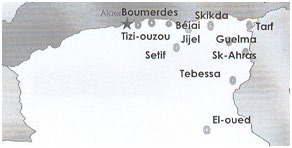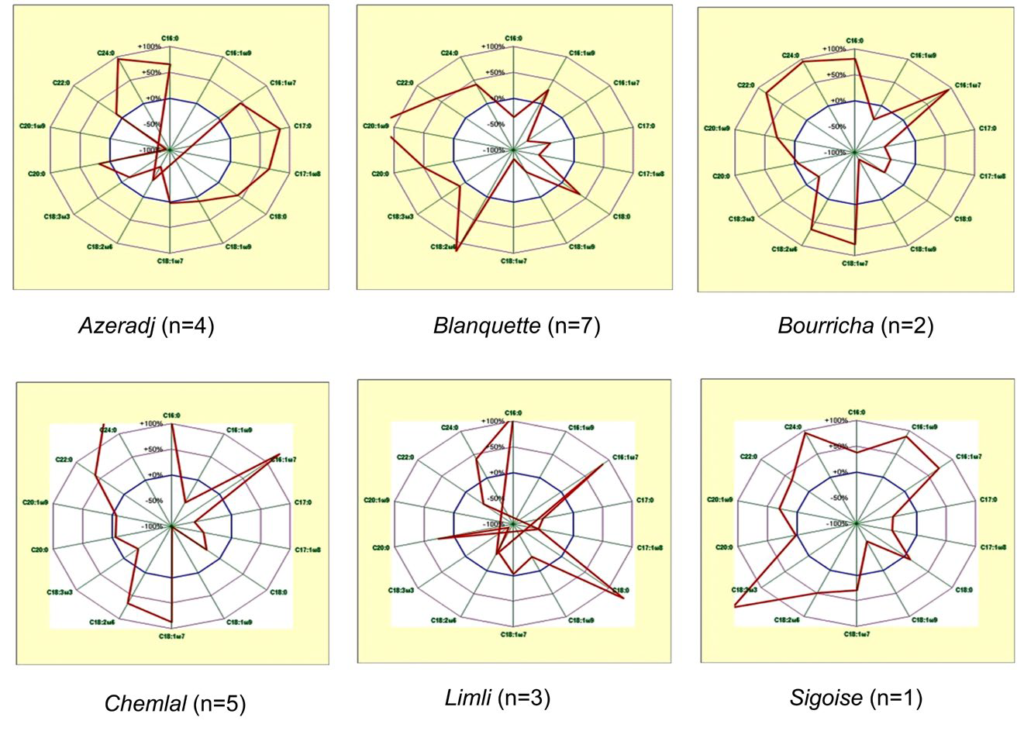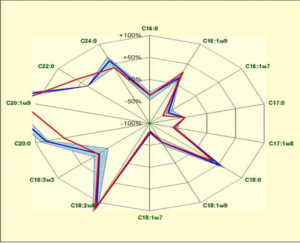INTRODUCTION
The characterization of olive oils in terms of cultivars and geographical origin is a matter of current debate. The quality and the peculiarity of olive oil is, in fact, influenced by several factors one of them being the associated cultivar.1
Algeria currently has almost 32×106 olive trees covering an area of 310,000 ha. Reports of NADP (National Plan for Agricultural Development) indicate that Algeria will achieve an overall coverage area of 420,000 ha in some years.2 The Algerian olive grove is rich in varieties, despite which only a few systematic studies have been conducted on the local cultivars to evaluate the quality of oil which is a priority relative to the requirements of the international market and international olivegrowing council (COI). The authentication of virgin olive oils (VOOs) has always been a problem of topical interest. The determination of the varietal origin of oils is important for quality control in the food industry and to assure fair trading. We have shown that the fatty acid composition of monovarietal olive oils or French protected designation of origin (PDO) oils were distinct characteristics of the cultivar or the geographical origin of olive oils.3,4
So, the aim of the present study is to investigate the varietal characterization of olive oils from six Algerian cultivars (Azeradj, Blanquette, Bouricha, Chemlal, Limli, Sigoise) by determining their fatty acid compositions and to create a “morphotype” for each cultivar. This data will be particularly effective in ensuring a possible protected designation of origin, their protection from related fraudulence activities,5 and in improving the quality of our oils by utilizing potential varieties taking the chemical composition of oil into account, to fulfill the requirements of the international market with respect to the commercial standards.
MATERIALS AND METHODS
Oil Samples
The samples came from the east and north-east of Algeria. Figure 1 represents the Algerian olive growing areas. Industrial virgin olive oil samples (n=22) were collected during two crop harvesting seasons (2009 and 2010). Oils came from six Algerian cultivars: Azeradj (n=4; Bejaia, Skikda), Blanquette (n=7; Guelma, Soouk-Ahras), Bourricha (n=2; Skikda), Chemlal (n=5; Bourmerdes, Setif, Tarf, Tebessa, Tizi-ouzou), Limli (n=3; Jijel) and Sigoise (n=1; El-Oued).
Figure 1: Geographical Origins of Algerian Olive Oils.

Fatty Acid Determination
Olive oil in n-heptane (0.12 g/2 mL) were transmethylated with a cold solution of KOH (2M) (200 µl) according to the norms of the European Standard NF EN ISO 5509 (2000).6 Fatty acid methyl esters (FAME) were analyzed in compliance with the European Standard NF EN ISO 5508 Norms (1995). The experimental analysis were performed using an Agilent Technology gas chromatograph 7890 A (GC) equipped with a split/split-less injector (t=250 °C) and a flame ionization detector (FID) (t=250 °C). A silica capillary column (60 m×0.25 mm i.d., 0.25 µm film thickness) coated with Sulpelcowax (Supelco) were used. The operating conditions of separation were such that the gas carriers (hydrogen) were used as the output. The inlet pressure of the hydrogen as carrier gases were 178 κPa with the ratio 1:70. The oven temperature conditions were as follows: 20 min at 210 °C, from 210 °C to 245 °C at 6 °C/min, 20 min at 245 °C and the flow rate were 13 ml/mn. The peaks were identified on the basis of the retention of known methyl esters.
Morphogramme
A radial plot helps create a “morphogramme” which is used in the characterization of each variety as per a “morphotype”. The “morphogramme” is designed as a radial representation using an Excel® spreadsheet, and on each axis the change in the variable with respect to the mean is represented. For each variable, centered mean gives the origin of the graphics (0%) that comes from a data base built from more than 2000 samples from various sources, grouped on the basis of variety and origin. The limits of variation (-100% to +100%) is equal to twice the standard deviation of the variable for fatty acids. The solid lines are the median values of individual fatty acids with respect to the dotted lines of first and second quartiles. Thus, on each axis, the value represented gives the percentage change compared to two times the standard deviation.
Nomenclature
The nomenclature of the fatty acids that were found in our study has been given as follows: Fatty acids 14:0, myristic acid (tetradecanoic acid); 16:0, palmitic acid (hexadecanoic acid); hypogeic acid (7-hexadecenoic acid); palmitoleic acid (9-hexadecenoic acid); 17:0, margaric acid (heptadecanoic acid); margaroleic acid (9-heptadecenoic acid); oleic acid (9-octadecenoic acid); cis vaccenic acid (11-octadecenoic acid); linoleic acid (9,12-octadecadienoic acid); linolenic acid (9,12,15-octadecatrienoic acid); 20:0, arachidic acid (eicosanoic acid); gondoic acid (11-eicosenoic acid)2 ; 22:0, behenic acid (docosanoic acid); 24:0, lignoceric acid (tetracosanoic acid).
RESULTS AND DISCUSSION
The fatty acid composition of oils were determined by gas chromatography of methyl esters. Fourteen fatty acids and squalene were identified in all samples. Oleic acid (18:1ω9), palmitic acid (16:0), linoleic acid (18:2ω6) and stearic acid (18:0) are the major fatty acids commonly found in olive oils. Palmitoleic acid (16:1ω7), hypogeic acid (16:1ω9), oleic acid (18:1ω9) and cisvaccenic acid (18:1ω7) are considered as separate entities by the European regulation, unlike the Codex Alimentarius which identifies them as a single component. Six minor fatty acids including margaric acid (17:0), margaroleic acid (17:1ω8), arachidic acid (20:0), gondoïque acid (20:1ω9),2 behenic acid (22:0) and lignoceric acid (24:0) were also determined. The fatty acids which leave slight traces (<0.01%) are not taken into account. Table 1 gives the results of the qualitative analysis of fatty acids of olive oils extracted from six cultivars. The “morphogrammes” are built from average values of fatty acids (Figure 2).><0.01%) are not taken into account. Table 1 gives the results of the qualitative analysis of fatty acids of olive oils extracted from six cultivars. The “morphogrammes” are built from average values of fatty acids (Figure 2).
Figure 2: “Morphogrammes” from Oils of Six Algerian Cultivars.

The profile of the fatty acids of the studied oils were in accordance with that of the International Olive Oil Council’s regulation,7 Codex Alimentarius8 and European Regulations9 excepted for Sigoise sample (18:3ω3>1%). Oils of different cultivars are characterized by different fatty acid compositions.
Our observations indicate that indeed, all the six varieties are very rich in oleic acid (C18: 1ω9). The flow rate of oleic acid in each studied variety for Azeradj is (72.70%) on average, followed by the Blanquette (67.18%), Bouricha (64.29%), Chemlal (63.73%), Limli (69.19%) and 66.37% for Sigoise (Table 1).
Table 1: Fatty Acid Compositions1 of Six Algerian Virgin Olive Oils.
| Table 1: Fatty Acid Compositions1 of Six Algerian Virgin Olive Oils. |
| Fattyacids |
Azeradj |
Blanquette |
Bouricha |
Chemlal |
Limli |
Sigoise
|
|
n= 4 |
n=7
|
n=2 |
n=5 |
n=3 |
n=1
|
|
Min |
Max |
Moy |
Min |
Max
|
Moy |
Min |
Max |
Moy |
Min |
Max |
Moy |
Min |
Max |
Moy |
|
| 16:0 |
13.12 |
14.54 |
14.01 |
9.54 |
11.66
|
10.77 |
14.31 |
14.72 |
14.51 |
14.12 |
16.29 |
15.18 |
15.17 |
15.84 |
15.47 |
13.12
|
| 16:1ω9 |
0.02 |
0.08 |
0.04 |
0.13 |
0.14 |
0.14
|
0.10 |
0.12 |
0.11 |
0.08 |
0.12 |
0.10 |
0.04 |
0.05 |
0.04 |
0.17 |
| 16:1 ω7 |
1.10 |
1.44 |
1.26 |
0.23 |
0.36 |
0.33 |
1.63 |
1.68 |
1.65 |
1.43 |
2.18 |
1.90 |
1.40 |
1.93 |
1.59 |
1.47
|
| 17:0 |
0.10 |
0.20 |
0.16 |
0.05 |
0.05 |
0.05
|
0.04 |
0.04 |
0.04
|
0.03 |
0.04 |
0.03 |
0.04 |
0.04 |
0.04 |
0.05 |
| 17:1 ω8 |
0.17 |
0.32 |
0.27 |
0.06 |
0.06 |
0.06 |
0.08 |
0.09 |
0.09 |
0.07 |
0.09 |
0.08 |
0.06 |
0.07 |
0.06 |
0.09
|
| 18:0 |
2.54 |
2.95 |
2.74 |
2.58 |
2.80 |
2.71
|
1.84 |
1.93 |
1.88 |
1.83 |
2.15 |
2.01 |
3.46 |
3.97 |
3.73 |
2.43 |
| 18:1 ω9 |
71.38 |
74.52 |
72.70 |
64.86 |
68.79 |
67.18 |
64.11 |
64.47 |
64.29 |
60.83 |
64.52 |
63.06 |
68.73 |
68.98 |
69.19 |
66.37
|
| 18:1 ω7 |
2.28 |
2.58 |
2.42 |
1.14 |
1.48 |
1.37
|
3.27 |
3.40 |
3.34 |
3.68 |
3.20 |
3.46 |
2.14 |
2.73 |
2.35 |
2.75 |
| 18:2 ω6 |
4.44 |
5.44 |
4.95 |
13.97 |
16.85 |
15.65 |
12.43 |
12.70 |
12.57 |
11.48 |
13.80 |
12.69 |
6.27 |
6.33 |
6.30 |
11.66
|
| 18:3 ω3 |
0.60 |
0.67 |
0.63 |
0.61 |
0.78 |
0.69
|
0.57 |
0.65 |
0.61
|
0.51 |
0.69 |
0.60 |
0.45 |
0.55 |
0.47 |
1.01 |
| 20:0 |
0.40
|
0.42 |
0.41 |
0.43 |
0.49 |
0.45 |
0.38 |
0.38 |
0.38 |
0.36 |
0.42 |
0.38 |
0.41 |
0.44 |
0.42 |
0.39
|
| 20:1 ω9 |
0.20 |
0.25 |
0.21 |
0.38 |
0.42 |
0.39
|
0.30 |
0.32 |
0.31
|
0.24 |
0.31 |
0.28 |
0.16 |
0.18 |
0.17 |
0.31 |
| 22:0 |
0.11 |
0.13 |
0.12 |
0.13 |
0.15 |
0.14 |
0.15 |
0.15 |
0.15 |
0.12 |
0.15 |
0.14 |
0.10 |
0.10 |
0.10 |
0.13
|
| 24:0 |
0.07 |
0.08 |
0.07 |
0.06 |
0.07 |
0.06
|
0.07 |
0.07 |
0.07 |
0.07 |
0.09 |
0.08 |
0.05 |
0.08 |
0.06 |
0.07
|
| 1Determined as methyl esters, % area of total fatty acids. |
The recorded percentage were close to those of the Tunisian varieties Chemlal, Chetoui and Zelmati which are 60.62%, 65.66% and 62.15% respectively10 like those of the French oil AOC Aix en-provence et Vallée des Baux.11
These results show that the six varieties of olive oils contain considerable quantities of essential fatty acids, in particular the Blanquette variety which contains 15.65% of linoleic acid followed by oils of the varieties Chemlal and Bouricha having 12.69% and 12.57% of 18:2ω6 respectively.
In addition, percentage of linolenic acid 18:3ω3 constitution varies between 0.47 to 0. 69% on an average for Azeradj, Blanquette, Bouricha, Chemlal and Limli except for the Sigoise sample.
Azeradj oil is the richest in 18:1ω9 (72.70%), 17:0 (0.16%) and 17:1 and the poorest in 18:2ω6 (4.95%) composition. These results are in agreement with the works of Bakhouche et al,12 on the olive oils of Azeradj variety cultivated in Algeria, where the oleic acid composition ranges between 55 to 83% and low values of linoleic acid. However, to analyse the composition of an essential fatty acid, Blanquette is the most promising variety following the Chemlal and Bouricha.
It should be noted that the average percentages in linoleic and linolenic acid composition in six oils during the 2-seasons prove to be sufficient to prevent a state of deficiency of fatty acids for the people using this as principal source of fat in their food.13
The fatty acid composition of Bouricha and Chemlal oils are similar. The “morphogrammes” allow the identification of “morphotypes” for each variety of oil. The Bouricha and Chemlal “morphogrammes” (Figure 2) confirm the resemblance between them. Moreover, the Blanquette “morphotype” is identical to that of the Tunisian cultivar Chetoui (Figure 3). This confirms the hypothesis of Loussert and Brousse14 on the identity and resemblance between these two cultivars.
This mode of representation is particularly effective to allow rapid visual identification of characteristics of olive oils.
Figure 3: “Morphogramme” Comparaison between Blanquette Oil (red) and Chétoui Oil (blue).

The fatty acids of olive oil play a significant role in contributing to its nutritional and organoleptic quality. Various factors, such as the variety, maturity of the fruit, climatic conditions, storage and extraction process used have an effect on the fatty acid composition of olive oils.13,15
CONCLUSION
The analysis of oil from six cultivars from East and South-western Algeria has shown minor differences in their fatty acid profile.
The complete results of this analysis were obtained only with oils belonging to the six varieties produced in the season 2009 and 2010. These varieties were cultivated over several seasons to confirm the real identity of these oils, to guarantee its rank in terms of quality in the world wide market of the olive oils and to select the best varieties amongst them. This will also make it possible to select the best varieties and to spread their cultivation throughout the national territory and confirm the Algerian AOC (designation of origin controlled).
CONFLICTS OF INTEREST
There are no competing interests related to this article.








